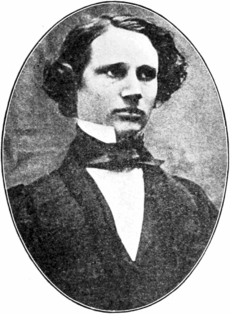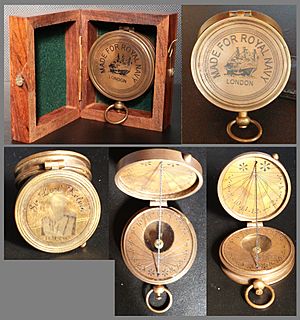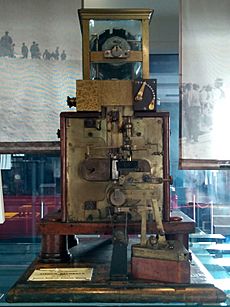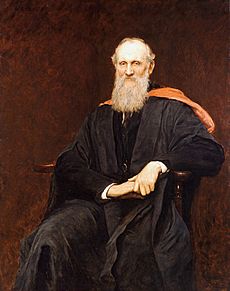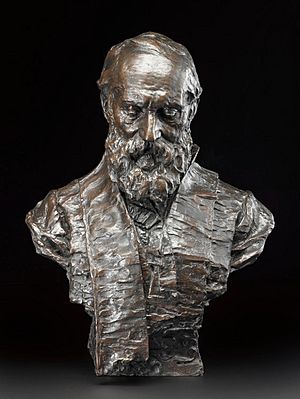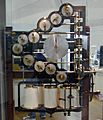Lord Kelvin facts for kids
Quick facts for kids
The Lord Kelvin
|
|
|---|---|
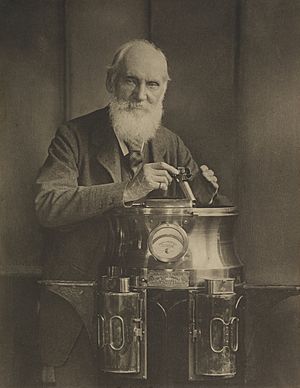
Kelvin, c. 1900, by T. & R. Annan & Sons
|
|
| President of the Royal Society | |
| In office 1 December 1890 – 30 November 1895 |
|
| Preceded by | Sir George Stokes |
| Succeeded by | The Lord Lister |
| Personal details | |
| Born | 26 June 1824 Belfast, United Kingdom of Great Britain and Ireland |
| Died | 17 December 1907 (aged 83) Largs, Scotland |
| Political party | Liberal (1865–1886) Liberal Unionist (from 1886) |
| Spouses |
Margaret Crum
(m. 1852; died 1870)Frances Blandy
(m. 1874–1907) |
| Children | None |
| Signature | |
| Alma mater | |
| Known for |
List
|
| Awards |
|
| Scientific career | |
| Institutions | University of Glasgow |
| Academic advisors | William Hopkins |
| Notable students | |
| It is believed the "PNP" in his signature stands for "Professor of Natural Philosophy". Kelvin also wrote under the pseudonym "P. Q. R." | |
William Thomson, 1st Baron Kelvin (born June 26, 1824 – died December 17, 1907) was a brilliant British mathematician, physicist, and engineer. He was born in Belfast, which is now in Northern Ireland.
For 53 years, he was a professor at the University of Glasgow in Scotland. There, he did important research on electricity and helped create the first and second laws of thermodynamics. He also played a big part in bringing different areas of physics together.
The unit for absolute temperature, called the kelvin, is named after him. He also helped figure out that the coldest possible temperature, absolute zero, is about -273.15 degrees Celsius.
Contents
Early Life and Education
William's Childhood Years
William Thomson was born to James Thomson and Margaret Thompson. His father was a mathematics and engineering teacher. William's mother, Margaret, passed away when he was only six years old in 1830.
William had six siblings, three brothers and two sisters. He and his older brother, James, were taught at home by their father. The younger children were taught by their older sisters.
In 1832, William's father became a professor of mathematics at Glasgow University. The family moved there in October 1833. William spent some of his teenage years in Germany and the Netherlands, where he focused on learning new languages.
Starting University Young
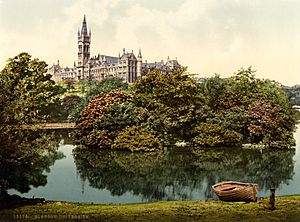
William went to the Royal Belfast Academical Institution, where his father taught. In 1834, at just 10 years old, he started studying at the University of Glasgow. At that time, the university allowed very bright young students to attend.
William was interested in both science and classic subjects like Greek and Latin. When he was 12, he won a prize for translating an ancient Greek text into English.
In 1839, he won an award for his essay on the shape of the Earth. This showed his early talent for math and creative thinking in science. He often returned to the ideas in this essay when he was feeling stressed.
William was very interested in the work of Joseph Fourier, a French mathematician. Fourier's ideas about heat were new and different from what most British scientists believed. William wrote his first published science paper, using the name P.Q.R., to defend Fourier's work.
Later, he wrote another important paper that connected the math of heat conduction with the math of electrostatics (the study of electric charges at rest). This connection was a very important idea in science.
Studying at Cambridge
In 1841, William's father sent him to Peterhouse, Cambridge, a famous university. William was good at sports like rowing and enjoyed music and literature. But his true passion was science, especially the study of electricity.
In 1845, William graduated as one of the top students in mathematics. He also won the First Smith's Prize, which is given for original research.
He was elected a fellow of Peterhouse in 1845. He then spent some time in Paris, working in a famous laboratory. In 1846, at only 22 years old, he became a professor at the University of Glasgow. He was now teaching in the same classroom where he had been a first-year student just a few years before!
Amazing Scientific Discoveries
Lord Kelvin's scientific work covered many different areas. He made discoveries that changed how we understand the world.
Electricity and Magnetism
Lord Kelvin helped create the international system for telegraphy, which made long-distance communication much faster. He also developed a mathematical method called "electrical images." This method was very helpful for solving problems about how electric charges interact.
He also studied atmospheric electricity, which is electricity in the air. He invented tools to measure the electric field in the atmosphere. One of his tools, the water dropper electrometer, was used for many years at observatories.
For his work on the transatlantic telegraph cable, which connected Europe and North America, he was knighted by Queen Victoria in 1866. He became known as Sir William Thomson.
Thermodynamics and Heat
Lord Kelvin made huge contributions to thermodynamics, the study of heat and energy. He helped develop the second law of thermodynamics and the absolute temperature scale, which is now measured in kelvins. He even introduced the word "thermodynamics" in 1848.
He also thought about the "heat death paradox" in 1862. This idea uses the laws of thermodynamics to suggest that the universe cannot be infinitely old. His work on heat and energy was key to building the foundations of modern physics.
Understanding Fluids
Lord Kelvin also studied hydrodynamics, which is the science of how fluids (like water) move. His research helped scientists understand the behavior of water and other liquids.
The Age of Earth
Lord Kelvin was very interested in how old the Earth is. He used physics to estimate its age. He believed that the Earth started very hot and slowly cooled down.
His first estimate in 1864 was that the Earth was between 20 million and 400 million years old. Over time, he refined his calculations. By 1897, he estimated the Earth was between 20 million and 40 million years old.
Lord Kelvin was great at solving practical problems. He invented tools that made communication and sea travel much better. He improved the mariner's compass, which was not very reliable before his work.
He also created a way to measure the depth of the deep sea while a ship was moving fast. He added a pressure gauge to his device to record the depth.
Becoming Lord Kelvin
In 1892, William Thomson was given the title of Baron Kelvin. This was to recognize his amazing achievements in thermodynamics and his political views. The title "Kelvin" comes from the River Kelvin, which flows near his laboratory at the University of Glasgow.
Personal Life
William Thomson was married twice but did not have any children.
In 1852, he married his childhood sweetheart, Margaret Crum. Sadly, Margaret's health was poor, and she passed away in 1870.
In 1874, he married Frances Anna Blandy, who was 13 years younger than him. He proposed to her by signaling from his ship as he approached the harbor in Madeira!
Later Years and Legacy
Lord Kelvin chose to stay at the University of Glasgow until he retired in 1899, even though he received offers from other famous universities. He was also involved in industry. Around 1899, he became the vice-chairman of Kodak Limited, the British branch of the famous camera company. In 1904, he became the Chancellor of the University of Glasgow.
He lived in a large red stone house called Netherhall in Largs, Scotland, which he built in the 1870s.
Death and Funeral

In November 1907, Lord Kelvin caught a cold, and his health worsened. He passed away at his home, Netherhall, in Largs on December 17, 1907.
His funeral was held on December 23, 1907, at Westminster Abbey in London. This is a very famous church where many important British figures are buried. Representatives from universities and countries around the world attended.
Lord Kelvin's grave is in the main part of the Abbey, close to the graves of other famous scientists like Isaac Newton and Charles Darwin.
He was a member of the Scottish Episcopal Church and attended services regularly. A memorial service was also held for him at the University of Glasgow.
William Thomson is also remembered on his family's grave in Glasgow Necropolis. The Royal Philosophical Society of Glasgow, where he was president twice, also placed a modern memorial there.
Interesting Facts About Lord Kelvin
- William had heart problems and almost died when he was 9 years old.
- He was good at several languages, including French, Ancient Greek, and Latin.
- He became a professor at Glasgow University at just 22 years old.
- He received the Royal Society's Copley Medal in 1883. He was also the president of the Royal Society from 1890 to 1895.
- In 1892, he became the first British scientist to be made a member of the House of Lords, which is part of the British Parliament.
- Thomson published more than 650 scientific papers and applied for 70 patents for his inventions.
- He was a strong believer in Christianity throughout his life.
- He was a well-known person in both Britain and America until he died.
- The Hunterian Museum at the University of Glasgow has a special exhibit about Lord Kelvin. It includes many of his original papers, tools, and other items.
Lord Kelvin's Famous Quotes
- "In science there is only physics; all the rest is stamp collecting."
- "Science is bound, by the everlasting vow of honour, to face fearlessly every problem which can be fairly presented to it."
- "The true measure of a man is what he would do if he knew he would never be caught."
Honors and Recognition
Lord Kelvin received many awards and honors during his life:
- He became a Fellow of the Royal Society of Edinburgh in 1847 and served as its president several times.
- He became a Fellow of the Royal Society in 1851 and was its president from 1890 to 1895.
- He was knighted in 1866 by Queen Victoria.
- He received honors from many countries, including Brazil, France, Prussia, and Belgium.
- In 1892, he was made Baron Kelvin. The title comes from the River Kelvin in Scotland. Since he had no children, his title ended when he died.
- He received the Knight Grand Cross of the Royal Victorian Order in 1896.
- He was one of the first people to receive the Order of Merit in 1902, a special honor given by the British monarch.
- He was buried in Westminster Abbey in London, next to Isaac Newton.
- Lord Kelvin has been featured on the £20 and £100 banknotes issued by the Clydesdale Bank in Scotland.
- In 2011, he was added to the Scottish Engineering Hall of Fame.
- World Refrigeration Day is celebrated on June 26th, his birthday, to honor his contributions.
Images for kids
-
The Thomson family tree: James Thomson (mathematician), James Thomson (engineer), and William Thomson, were all professors at the University of Glasgow.
-
Kelvin on a pleasure cruise on the River Clyde aboard the steamer Glen Sannox for his 17 June 1896 "jubilee" as Professor of Natural Philosophy at Glasgow
See also
 In Spanish: William Thomson para niños
In Spanish: William Thomson para niños
- People on Scottish banknotes
- List of things named after Lord Kelvin
- Kelvin (unit)
- List of presidents of the Royal Society


